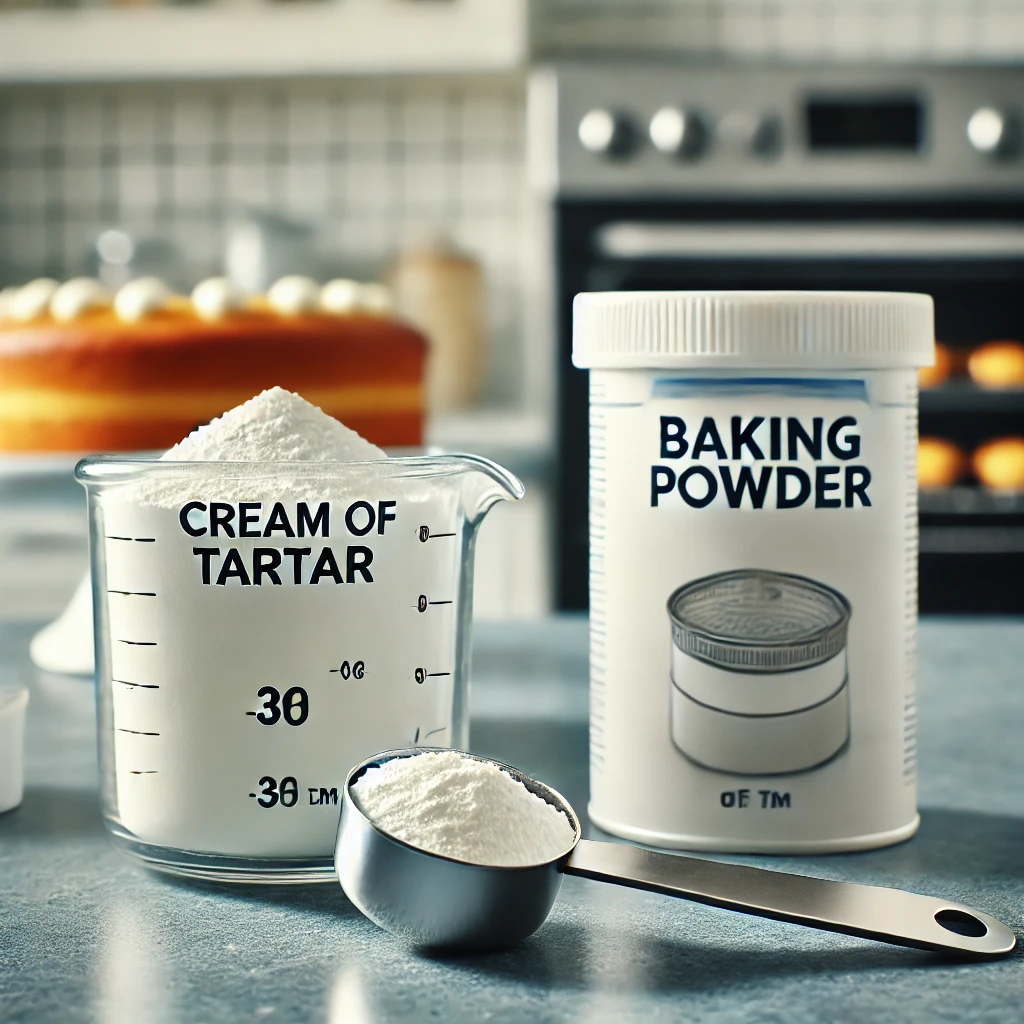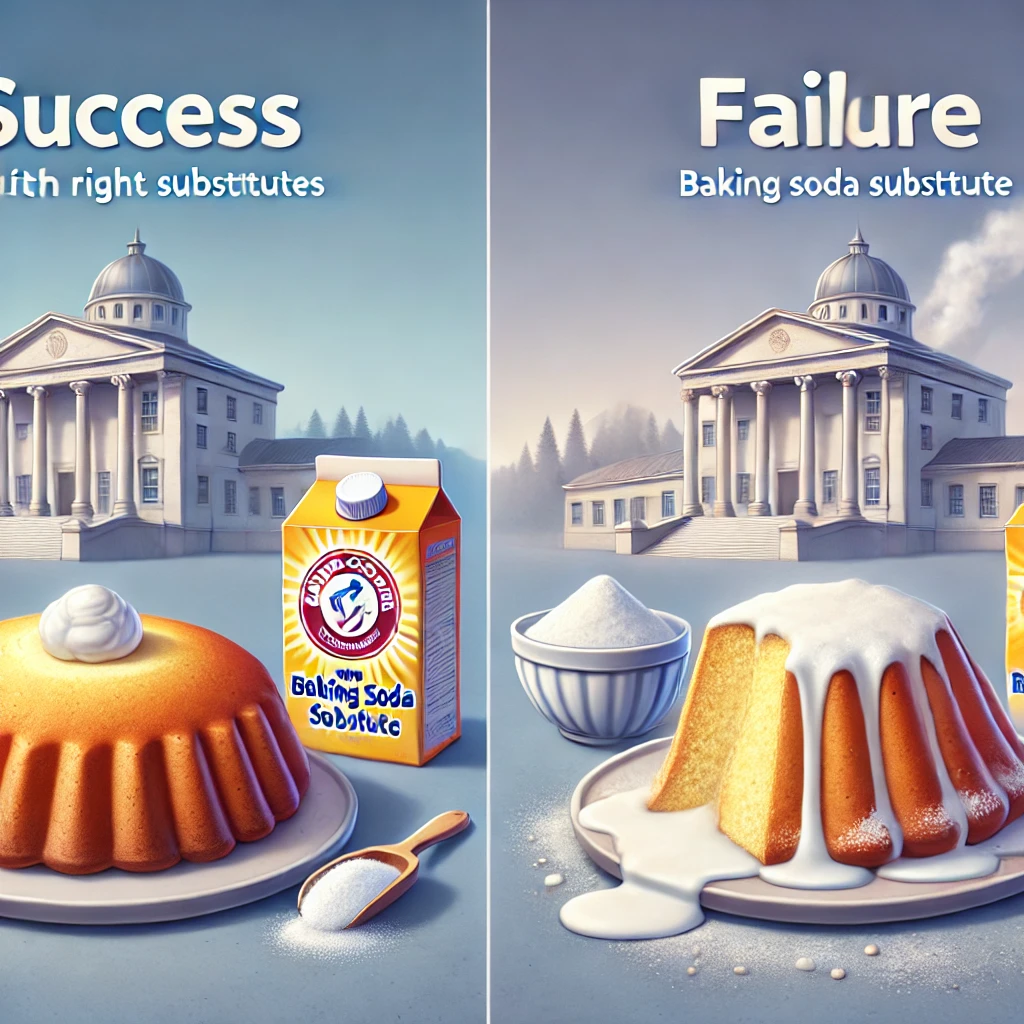This post may include affiliate links which means I may receive a commission from purchases made through links. I will only recommend products I have personally used. Learn more on my private policy page.

If you’ve ever been in the middle of baking, only to realize you’re out of baking soda, you know the frustration.
Baking soda is a key ingredient in many recipes, helping baked goods rise and achieve the perfect texture.
But what happens when you don’t have it on hand?
The good news is that there are several baking soda substitutes you can use in a pinch, many of which you likely already have in your pantry.
In this blog post, we’ll explore the 10 best baking soda substitutes for every recipe.
Whether you’re baking cookies, cakes, or bread, we’ll show you how to make successful swaps so your delicious treats turn out perfectly.
Why Do We Need a Baking Soda Substitute?

When baking soda is combined with an acid, it emits gas, which causes doughs and batters to rise.
This process gives baked goods their light, fluffy texture and helps them rise properly in the oven.
However, not everyone keeps baking soda on hand, and sometimes, you might run out at the most inconvenient time.
That’s where finding a good baking soda substitute comes in handy.
The right substitute can replicate the leavening effect, ensuring your baked goods turn out just as delicious without the missing ingredient.
The key to finding the best baking soda substitute is understanding what role it plays in your recipe and choosing an alternative that offers similar results.
Let’s dive into the best options you can use when you’re out of baking soda.
1. Baking Powder
How It Works
Baking powder is the most common and effective baking soda substitute.
It’s actually a combination of baking soda and an acid (usually cream of tartar), along with a drying agent like cornstarch.
Since it already contains an acid, you don’t need to add one to your recipe, making it a convenient 1:1 replacement.
How to Use It
For every teaspoon of baking soda called for in a recipe, use 3 teaspoons of baking powder.
This substitution works well in most baked goods, from cakes to cookies.
Keep in mind that baking powder has a slightly different chemical composition, so your end result might be a bit denser, but it’s still a reliable alternative.
2. Self-Rising Flour

How It Works
Self-rising flour is another excellent baking soda substitute, especially if you’re making quick breads, muffins, or pancakes.
This type of flour contains both baking powder and salt, which means you won’t need to add these ingredients separately.
How to Use It
To use self-rising flour as a substitute, replace all-purpose flour with an equal amount of self-rising flour, and omit the baking soda and any additional salt in the recipe.
This works best in recipes where the main leavening agent is baking soda.
3. Club Soda

How It Works
Club soda contains carbon dioxide, which can mimic the leavening action of baking soda.
While it’s not as strong as other substitutes, club soda can work in recipes that require a liquid ingredient, like pancakes, waffles, or even cakes.
How to Use It
Replace the liquid in your recipe with an equal amount of club soda.
This will introduce bubbles that can help give your baked goods a little lift.
Club soda works best in light, delicate recipes where the texture is key.
4. Lemon Juice and Baking Powder

How It Works
If you have baking powder but still want the extra lift that comes from a more acidic reaction, combining baking powder with lemon juice can be an effective baking soda substitute.
Lemon juice is highly acidic and can activate the baking powder, creating a light and fluffy texture in your baked goods.
How to Use It
For every teaspoon of baking soda, use 2 teaspoons of baking powder and 1 teaspoon of lemon juice.
This combination works well in cakes, muffins, and scones.
Just be aware that lemon juice may add a slight citrus flavor to your recipe.
5. Buttermilk

How It Works
Buttermilk is naturally acidic, making it a great baking soda substitute when paired with baking powder.
The acidity in buttermilk helps activate the baking powder, leading to a similar leavening effect as baking soda.
How to Use It
Replace the liquid in your recipe with an equal amount of buttermilk, and use 2 to 3 of your baking powder in place of the soda.
This is an excellent choice for pancakes, waffles, and biscuits, where buttermilk adds richness and tang.
6. Yogurt

How It Works
Similar to buttermilk, yogurt is another acidic ingredient that can activate baking powder as a baking soda substitute.
Plain, unsweetened yogurt works best, as it doesn’t introduce any extra flavors or sugars into your recipe.
How to Use It
Use yogurt in place of the liquid in your recipe, and add 2 to 3 of your baking powder.
This works particularly well in quick breads, cakes, and muffins, where the yogurt’s acidity can complement the sweetness of the recipe.
7. Vinegar and Baking Powder

How It Works
Vinegar is highly acidic, which makes it a strong choice for activating baking powder as a baking soda substitute.
When combined with baking powder, vinegar produces the bubbles necessary to give your baked goods the lift they need.
How to Use It
For every teaspoon of baking soda, use 1 teaspoon of vinegar and 2 teaspoons of baking powder.
Vinegar can have a strong flavor, so it’s best to use it in recipes where the taste can be masked or where a tangy flavor is acceptable.
8. Molasses

How It Works
Molasses is a naturally acidic ingredient that can work as a baking soda substitute when paired with baking powder.
While molasses adds a rich, sweet flavor, it also helps activate baking powder, which can provide the lift needed in your baked goods.
How to Use It
For every teaspoon of baking soda, use 1 teaspoon of molasses along with 1 teaspoon of baking powder.
This substitute works best in recipes where the flavor of molasses complements the dish, such as gingerbread or spice cookies.
9. Cream of Tartar and Baking Powder

How It Works
Cream of tartar is an acidic powder that can help activate baking powder as a baking soda substitute.
This combination works well for recipes that rely on both leavening and flavor balance.
How to Use It
For every teaspoon of baking soda, use 2 teaspoons of baking powder and 1 teaspoon of cream of tartar.
This method works well in cookies, cakes, and other baked goods where a soft texture is desired.
10. Whipped Egg Whites

How It Works
Whipped egg whites are a natural leavening agent, and they can help create light, airy baked goods without the need for baking soda.
The air trapped in the egg whites expands as the dish bakes, giving it a fluffy texture.
How to Use It
Beat egg whites until stiff peaks form, then gently fold them into your batter.
This technique is best for recipes like soufflés, sponge cakes, and meringues, where a delicate, airy texture is key.
When Not to Use Certain Baking Soda Substitutes: What Not to Do

While there are plenty of great baking soda substitutes, not all of them work equally well in every recipe.
Some substitutes might alter the flavor, texture, or structure of your baked goods, so it’s important to know when not to use certain alternatives.
Below are a few key tips to avoid common mistakes when swapping out baking soda.
1. Don’t Use Baking Powder as a Direct 1:1 Substitute for Baking Soda
While baking powder is a good substitute, it’s not a direct 1:1 replacement for baking soda.
Since baking powder contains additional ingredients (acid and cornstarch), using the same amount as baking soda can lead to a heavy, dense texture.
Remember, for every 1 teaspoon of baking soda, you should use 3 teaspoons of baking powder to maintain the leavening effect.
When Not to Use Baking Powder:
- In recipes where a strong leavening action is required, such as bread or dense cakes.
- Baking powder alone may not provide enough rise, leading to a heavier final product.
2. Avoid Using Vinegar in Delicate or Lightly Flavored Recipes
Vinegar is highly acidic and has a distinct, tangy taste.
While it’s effective as a baking soda substitute when combined with baking powder, it can leave a noticeable flavor in certain recipes, especially those with delicate or mild flavors.
The acidic taste can overwhelm the dish, making it unsuitable for recipes like sugar cookies or vanilla cakes.
When Not to Use Vinegar:
- In recipes where a strong vinegar taste would be unwelcome, such as in light cakes, vanilla-flavored cookies, or simple muffins.
3. Be Careful Using Buttermilk or Yogurt in Recipes Without Reducing Liquid Content
Buttermilk and yogurt are excellent substitutes due to their acidity, but they are also liquids.
Adding them to a recipe without adjusting the other liquid ingredients can result in a batter that’s too runny, which can affect the texture and consistency of your baked goods.
What Not to Do:
- Don’t add buttermilk or yogurt without reducing the other liquid components in your recipe (like milk or water).
- For every 1 cup of buttermilk or yogurt you use, reduce the other liquid by the same amount to keep the balance.
When Not to Use Buttermilk or Yogurt:
- In recipes where the texture is critical and a precise consistency is needed, like in bread doughs or pie crusts.
4. Don’t Use Club Soda for Recipes Requiring Strong Leavening
Club soda can add a light lift due to the carbon dioxide it contains, but it’s not as powerful as baking soda.
It works best in light batters but won’t provide enough lift for more substantial recipes like bread or thick cakes.
It’s also not suitable for recipes that rely heavily on structure, like cookies, as it may create an airy, unstable texture.
When Not to Use Club Soda:
- In dense or structured recipes that require a strong leavening agent, such as bread, brownies, or thick cakes.
5. Avoid Molasses in Recipes Where the Flavor Would Clash
Molasses is a great option because of its acidity, but it has a very distinct, rich flavor that can clash with some baked goods.
Molasses works best in darker, richer recipes like gingerbread or spice cakes.
Using it in lighter recipes like sugar cookies or vanilla cakes will overpower the delicate flavors and might make the dish too sweet or sticky.
When Not to Use Molasses:
- In recipes where molasses would alter the flavor too much, such as vanilla cupcakes, sugar cookies, or light sponge cakes.
6. Don’t Use Egg Whites in Heavier Baked Goods
Whipped egg whites are an excellent leavening substitute in recipes that require a light and airy texture, but they aren’t suitable for dense baked goods.
Egg whites create a delicate structure that works well in recipes like soufflés, meringues, or chiffon cakes, but they won’t have enough lifting power for heavier cakes or bread.
When Not to Use Whipped Egg Whites:
- In recipes where the batter is thick or dense, like pound cake, brownies, or bread.
- The lightness of the egg whites may not provide enough structure for the recipe to rise properly.
7. Don’t Use Self-Rising Flour in Recipes That Already Contain Baking Powder
Self-rising flour contains both baking powder and salt, so adding it to a recipe that already calls for baking powder can lead to over-leavening.
This can cause your baked goods to rise too quickly and then collapse, resulting in a dense, undercooked interior.
When Not to Use Self-Rising Flour:
- In recipes that already call for leavening agents like baking powder or baking soda.
- Using both can disrupt the balance of ingredients and ruin the texture of your baked goods.
Substituting Wisely for Best Results
Finding a good baking soda substitute can save your recipe in a pinch, but it’s important to choose the right one for the specific dish you’re making.
Not every substitute will work perfectly in every situation, and some may alter the flavor, texture, or appearance of your baked goods.
Always adjust the recipe carefully and consider the substitute’s impact on both the flavor and texture of your final product.
Now that you know which baking soda substitutes to avoid in certain situations, you can confidently bake without worrying about running out of baking soda!
Conclusion: Choosing the Right Baking Soda Substitute
When you’re out of baking soda, there’s no need to panic.
Whether you choose baking powder, buttermilk, or another option, there’s a baking soda substitute for every recipe.
The key is to understand the role of leavening in your dish and choose the substitute that best matches the texture and flavor you want to achieve.
Keep in mind that while these substitutes can replicate the leavening action of baking soda, the results may vary slightly depending on the recipe.
Experiment with different options to find the one that works best for your needs, and you’ll never have to worry about running out of baking soda again.
With these 10 best baking soda substitutes, you’re ready to tackle any recipe and keep your baking adventures going without a hitch!





